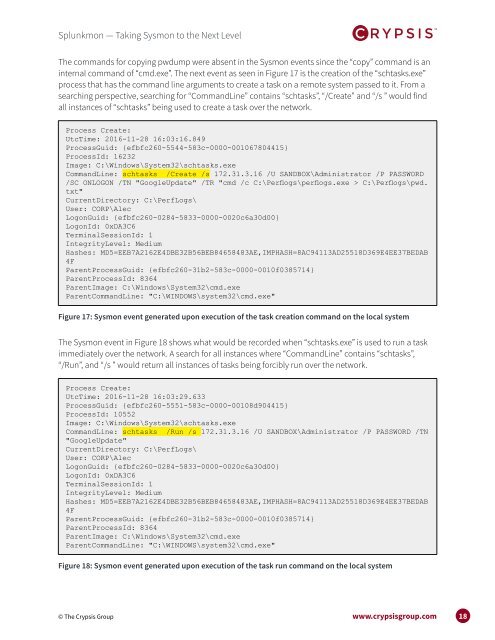You also want an ePaper? Increase the reach of your titles
YUMPU automatically turns print PDFs into web optimized ePapers that Google loves.
<strong>Splunkmon</strong> <strong>—</strong> <strong>Taking</strong> <strong>Sysmon</strong> <strong>to</strong> <strong>the</strong> <strong>Next</strong> <strong>Level</strong><br />
The commands for copying pwdump were absent in <strong>the</strong> <strong>Sysmon</strong> events since <strong>the</strong> “copy” command is an<br />
internal command of “cmd.exe”. The next event as seen in Figure 17 is <strong>the</strong> creation of <strong>the</strong> “schtasks.exe”<br />
process that has <strong>the</strong> command line arguments <strong>to</strong> create a task on a remote system passed <strong>to</strong> it. From a<br />
searching perspective, searching for “CommandLine” contains “schtasks”, “/Create” and “/s ” would find<br />
all instances of “schtasks” being used <strong>to</strong> create a task over <strong>the</strong> network.<br />
Process Create:<br />
UtcTime: 2016-11-28 16:03:16.849<br />
ProcessGuid: {efbfc260-5544-583c-0000-001067804415}<br />
ProcessId: 16232<br />
Image: C:\Windows\System32\schtasks.exe<br />
CommandLine: schtasks /Create /s 172.31.3.16 /U SANDBOX\Administra<strong>to</strong>r /P PASSWORD<br />
/SC ONLOGON /TN "GoogleUpdate" /TR "cmd /c C:\Perflogs\perflogs.exe > C:\Perflogs\pwd.<br />
txt"<br />
CurrentDirec<strong>to</strong>ry: C:\PerfLogs\<br />
User: CORP\Alec<br />
LogonGuid: {efbfc260-0284-5833-0000-0020c6a30d00}<br />
LogonId: 0xDA3C6<br />
TerminalSessionId: 1<br />
Integrity<strong>Level</strong>: Medium<br />
Hashes: MD5=EEB7A2162E4DBE32B56BEB84658483AE,IMPHASH=8AC94113AD25518D369E4EE37BEDAB<br />
4F<br />
ParentProcessGuid: {efbfc260-31b2-583c-0000-0010f0385714}<br />
ParentProcessId: 8364<br />
ParentImage: C:\Windows\System32\cmd.exe<br />
ParentCommandLine: "C:\WINDOWS\system32\cmd.exe"<br />
Figure 17: <strong>Sysmon</strong> event generated upon execution of <strong>the</strong> task creation command on <strong>the</strong> local system<br />
The <strong>Sysmon</strong> event in Figure 18 shows what would be recorded when “schtasks.exe” is used <strong>to</strong> run a task<br />
immediately over <strong>the</strong> network. A search for all instances where “CommandLine” contains “schtasks”,<br />
“/Run”, and “/s ” would return all instances of tasks being forcibly run over <strong>the</strong> network.<br />
Process Create:<br />
UtcTime: 2016-11-28 16:03:29.633<br />
ProcessGuid: {efbfc260-5551-583c-0000-00108d904415}<br />
ProcessId: 10552<br />
Image: C:\Windows\System32\schtasks.exe<br />
CommandLine: schtasks /Run /s 172.31.3.16 /U SANDBOX\Administra<strong>to</strong>r /P PASSWORD /TN<br />
"GoogleUpdate"<br />
CurrentDirec<strong>to</strong>ry: C:\PerfLogs\<br />
User: CORP\Alec<br />
LogonGuid: {efbfc260-0284-5833-0000-0020c6a30d00}<br />
LogonId: 0xDA3C6<br />
TerminalSessionId: 1<br />
Integrity<strong>Level</strong>: Medium<br />
Hashes: MD5=EEB7A2162E4DBE32B56BEB84658483AE,IMPHASH=8AC94113AD25518D369E4EE37BEDAB<br />
4F<br />
ParentProcessGuid: {efbfc260-31b2-583c-0000-0010f0385714}<br />
ParentProcessId: 8364<br />
ParentImage: C:\Windows\System32\cmd.exe<br />
ParentCommandLine: "C:\WINDOWS\system32\cmd.exe"<br />
Figure 18: <strong>Sysmon</strong> event generated upon execution of <strong>the</strong> task run command on <strong>the</strong> local system<br />
© The Crypsis Group www.crypsisgroup.com 18
















